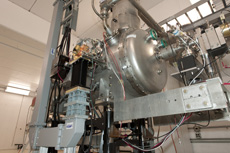SRF cryogenics system proves its 'cool' factor
 |
| Engineers recently cooled this SRF test unit to 2 degrees Kelvin, or minus 271 degrees Celsius. |
Fermilab has passed another major milestone on the road to becoming an expert in superconducting radio frequency technology.
In early October, in the first test of the cryogenics system at the RF-unit test facility at the New Muon Lab, Fermilab engineers cooled a superconducting capture cavity to 2 degrees Kelvin, or minus 271 degrees Celsius. This is the temperature needed for cavities that could be used in next-generation accelerators such as the proposed Project X. The successful test was the final step in commissioning the cryogenic system at the new test facility.
"It proves that our system works and we know what we are doing," said engineer Jerry Leibfritz.
Scientists will use the capture cavity, which resides inside a mini-cryomodule that can hold a single SRF cavity, to test the cryogenic and RF power systems recently installed in the New Muon Lab. Next, Fermilab plans to test cryomodules similar to those intended for the proposed Project X and the proposed ILC.
Because of limited funds, engineers used recycled parts from the Tevatron at Fermilab and took a giant vacuum pump out of storage from Thomas Jefferson National Accelerator Facility to construct the current cryogenic plant. With the help of funding from the American Recovery and Reinvestment Act, Fermilab will build a larger cryogenic plant adjacent to the New Muon Laboratory to increase dramatically the capability of the current facility.
Facilities to build and test cryomodules exist at DESY in Germany and are under construction at KEK in Japan. In the United States, Fermilab is the only laboratory capable of building and testing these multi-million dollar ILC-type cryomodules. Help from international partners, such as DESY, INFN and KEK, and U.S. partners, including Argonne, Jefferson Lab, SLAC and Cornell, made the construction of Fermilab's test facility possible.
— Tona Kunz |